Liquid Overlay-Induced Donor Plant Vigor and Initial Ammonium-Free Regrowth Medium Are Critical to the Cryopreservation of Scrophularia kakudensis
Abstract
:1. Introduction
2. Results
2.1. In Vitro Propagation of Scrophularia kakudensis
2.1.1. Effect of Subculture Medium and Conditions
2.1.2. Effect of Liquid Overlay on Top of the Gelled Medium
2.1.3. Effect of Liquid Overlay Composition (Nutrients and Sucrose)
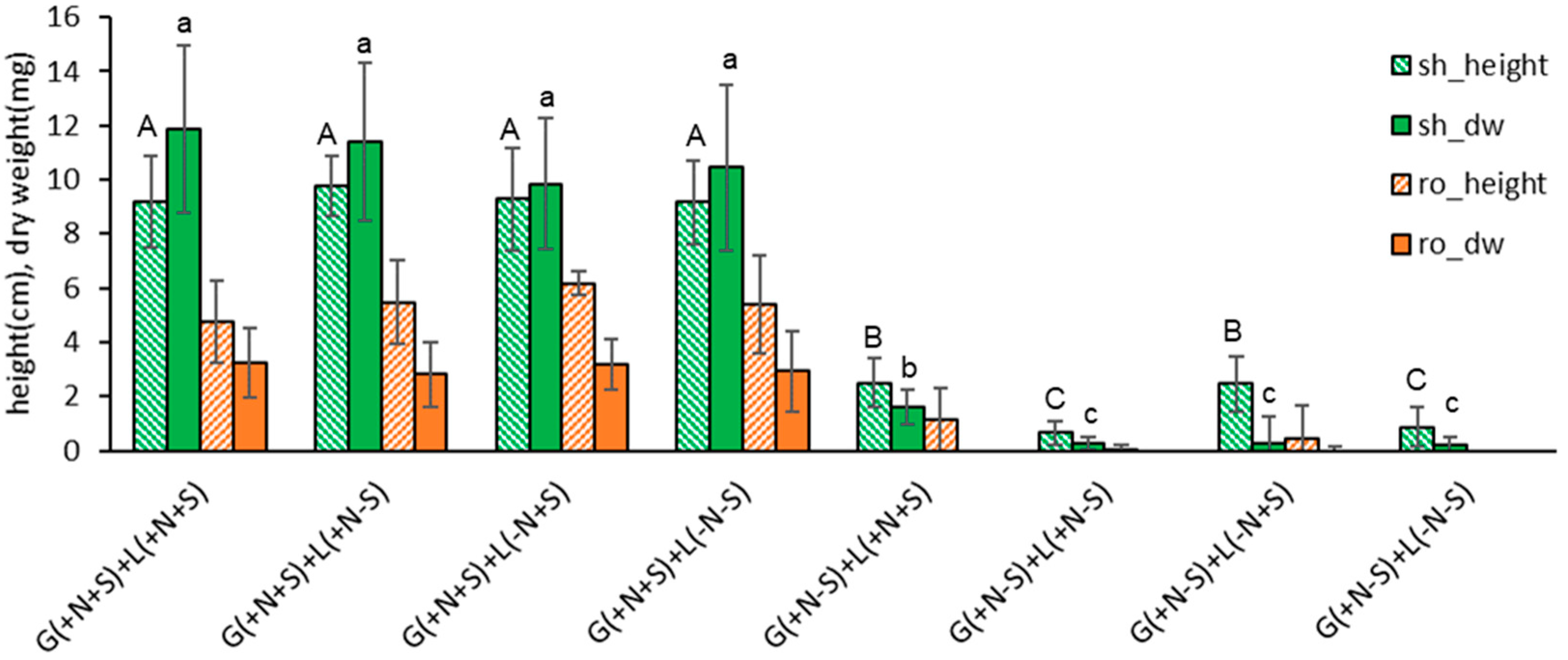
2.2. Cryopreservation of Scrophularia kakudensis Shoot Tips
2.2.1. Pre-LN Stages in Droplet-Vitrification Procedure
2.2.2. Three-Step Regrowth in Droplet-Vitrification Procedure
2.2.3. Effect of Liquid Overlay (Timing and Composition) in Droplet-Vitrification Procedure
3. Discussion
3.1. In Vitro Propagation System of Endangered Wild Species
3.2. Droplet-Vitrification Procedure—Protocol Development
3.3. Droplet-Vitrification Procedure—Liquid Overlay-Induced Donor Plant Vigor
4. Materials and Methods
4.1. Plant Material, In Vitro Establishment and Preparation of Donor Plants
4.2. Effect of Subculture Conditions in In Vitro Propagation of Scrophularia kakudensis
4.3. Experimental Design of Treatments in the Droplet-Vitrification (DV) Procedure
4.3.1. Standard Droplet-Vitrification Procedure
4.3.2. Sets of Experimental Conditions—Pre-LN Stages, Three-Step Regrowth, and Liquid Overlay
4.4. Recovery Assessment and Statistical Analysis
5. Conclusions
Author Contributions
Funding
Data Availability Statement
Conflicts of Interest
References
- Han, G.; So, S.; Lee, J.H.; Kim, M. Taxonomy of the genus Scrophularia (Scrophulariaceae) in Korea. Korean J. Plant Taxon. 2009, 39, 237–246. [Google Scholar] [CrossRef]
- Jang, H.D.; Kim, T.H.; Oh, B.U. A taxonomic review of Scrophularia kakudensis Franch. and its relatives. Korean J. Plant Taxon. 2011, 41, 345–352. [Google Scholar] [CrossRef]
- Manivannan, A.; Soundararajan, P.; Park, Y.G.; Jeong, B.R. In vitro propagation, phytochemical analysis, and evaluation of free radical scavenging property of Scrophularia kakudensis Franch tissue extracts. Biomed. Res. Int. 2015, 2015, 480564. [Google Scholar] [CrossRef]
- Bunn, E.; Turner, S.R.; Dixon, K.W. Biotechnology for saving rare and threatened flora in a biodiversity hotspot. Vitr. Cell. Dev. Biol.-Plant 2011, 47, 188–200. [Google Scholar] [CrossRef]
- Pence, V.C.; Ballesteros, D.; Walters, C.; Reed, B.M.; Philpott, M.; Dixon, K.W.; Pritchard, H.W.; Culley, T.M.; Vanhove, A.C. Cryobiotechnologies: Tools for expanding long-term ex situ conservation to all plant species. Biol. Conserv. 2020, 250, 108736. [Google Scholar] [CrossRef]
- Coelho, N.; Gonçalves, S.; Romano, A. Endemic plant species conservation: Biotechnological approaches. Plants 2020, 9, 345. [Google Scholar] [CrossRef] [PubMed]
- Breman, E.; Ballesteros, D.; Castillo-Lorenzo, E.; Cockel, C.; Dickie, J.; Faruk, A.; O’Donnell, K.; Offord, C.A.; Pironon, S.; Sharrock, S.; et al. Plant Diversity Conservation Challenges and Prospects—The Perspective of Botanic Gardens and the Millennium Seed Bank. Plants 2021, 10, 2371. [Google Scholar] [CrossRef] [PubMed]
- Reed, B.M. Implementing cryogenic storage of clonally propagated plants. CryoLetters 2001, 22, 97–104. [Google Scholar] [PubMed]
- Yoon, J.W.; Kim, H.H.; Ko, H.C.; Hwang, H.S.; Cho, E.G.; Sohn, J.K.; Engelmann, F. Cryopreservation of cultivated and wild potato varieties by droplet vitrification: Effect of subculture of mother-plants and of preculture of shoot tips. CryoLetters 2006, 27, 211–222. [Google Scholar]
- Lee, H.; Park, H.; Popova, E.; Lee, Y.Y.; Park, S.U.; Kim, H.H. Ammonium-free medium is critical for regeneration of shoot tips of the endangered species Pogostemon yatabeanus cryopreserved using droplet-vitrification. CryoLetters 2021, 45, 290–299. [Google Scholar]
- Association of Official Seed Analysts (AOSA). Seed Vigor Testing Handbook; Baalbaki, R.Z.B., Ed.; Association of Official Seed Analysts: Ithaca, NY, USA, 2009; Volume 32, Available online: https://books.google.co.kr/books?id=UO1UswEACAAJ (accessed on 3 February 2023).
- Kim, H. Optimizing the Droplet-Vitrification Procedure by Balancing the Cryoprotection and Cytotoxicity of Alternative Plant Vitrification Solutions Based on the Nature of Donor Plant Vigor. Plants 2023, 12, 4040. [Google Scholar] [CrossRef] [PubMed]
- Lee, H.-E.; Popova, E.; Park, H.-N.; Park, S.-U.; Kim, H.-H. Optimization of a cryopreservation method for the endangered Korean species Pogostemon yatabeanus using a systematic approach: The key role of ammonium and growth regulators. Plants 2021, 10, 2018. [Google Scholar] [CrossRef]
- Hussien, F.A.; Osman, M.A.; Idris, T.I.M. The influence of liquid media support, gelling agents and liquid overlays on performance of in vitro cultures of ginger (Zingiber officinale). Intl. J. Sci. Res. Pub. 2014, 4, 2250–3153. Available online: https://api.semanticscholar.org/CorpusID:32350901 (accessed on 3 February 2023).
- Choi, C.H.; Popova, E.; Lee, H.; Park, S.U.; Ku, J.; Kang, J.H.; Kim, H.H. Cryopreservation of endangered wild species, Aster altaicus var. uchiyamae Kitam, using droplet-vitrification procedure. CryoLetters 2019, 40, 113–122. [Google Scholar]
- Lee, H.; Kim, H. Vigorous growing of donor plantlets by liquid overlay in subcultures is the key to cryopreservation of endangered species Pogostemon yatabeanus. Plants 2022, 11, 3127. [Google Scholar] [CrossRef]
- Zilani, R.A.K.M.; Lee, H.; Popova, E.; Kim, H. In vitro multiplication and cryopreservation of Penthorum chinense shoot tips. Life 2022, 12, 1759. [Google Scholar] [CrossRef] [PubMed]
- Kang, K.S.; Veeder, G.T.; Mirrasoul, P.J.; Kaneko, T.; Cottrell, I.W. Agar-like polysaccharide produced by a Pseudomonas species: Production and basic properties. Appl. Environ. Microbiol. 1982, 43, 1086–1091. [Google Scholar] [CrossRef]
- Franck, T.; Kevers, C.; Gaspar, T.; Dommes, J.; Deby, C.; Greimers, R.; Serteyn, D.; Deby-Dupont, G. Hyperhydricity of Prunus avium shoots cultured on gelrite: A controlled stress response. Plant Physiol. Biochem. 2004, 42, 519–527. [Google Scholar] [CrossRef] [PubMed]
- Fira, A.; Clapa, D. The influence of the gelling agent upon multiplication rate in Sequoia sempervirens. Bull. UASVM 2008, 65, 463. [Google Scholar]
- Benjelloun, J.; Taoufyq, A.; El Abidine Triqui, Z.; Alami, Q.L.; Layachi, R.; Smouni, A.; Bouzroud, S.; Guedira, A. Improvement of in vitro germination of Cycas revoluta zygotic embryos using gelrite as gelling agent. Adv. Hort. Sci. 2020, 34, 349–354. [Google Scholar] [CrossRef]
- Klimaszewska, K.; Bernier-Cardou, M.; Cyr, D.R.; Sutton, B.C.S. Influence of gelling agents on culture medium gel strength, water availability, tissue water potential, and maturation response in embryogenic cultures of Pinus strobus L. In Vitro Cell. Dev. Biol.-Plant 2000, 36, 279–286. [Google Scholar] [CrossRef]
- Sah, S.K.; Kaur, A.; Jagdeep, S.S. High frequency embryogenic callus induction and whole plant regeneration in Japonica rice Cv. kitaake. J. Rice Res. 2014, 2, 125. [Google Scholar] [CrossRef]
- Toaima, N.; Bosila, H.; El-Ateeq, A.E. In vitro growth regulators, gelling agents and sucrose levels affect micropropagation of Gypsophila paniculate L. Middle East J. Agric. 2016, 5, 313. [Google Scholar]
- Polivanova, O.B.; Bedarev, V.A. Hyperhydricity in Plant Tissue Culture. Plants 2022, 11, 3313. [Google Scholar] [CrossRef]
- Rojas-Martinez, L.I.; Visser, R.G.F.; de Klerk, G.J.M. The hyperhydricity syndrome: Waterlogging of plant tissues as a major cause. Propag. Ornam. Plants 2010, 10, 169–175. [Google Scholar]
- Kemat, N.; Visser, R.G.F.; Krens, F.A. Hypolignification: A Decisive Factor in the Development of Hyperhydricity. Plants 2021, 10, 2625. [Google Scholar] [CrossRef]
- Pullman, G.S.; Skryabina, A. Liquid medium and liquid overlays improve embryogenic tissue initiation in conifers. Plant Cell Rep. 2007, 26, 873–887. [Google Scholar] [CrossRef]
- Yi, J.Y.; Lee, S.Y.; Lee, G.A.; Jeong, J.W.; Cho, J.H.; Kim, H.H. Improvement of the droplet-vitrification method for the cryopreservation of cultivated potato shoot tips. Korean J. Breed. Sci. 2012, 44, 94–99. [Google Scholar]
- Vujović, T.; Ružić, Đ.; Cerović, R. Effect of the duration of liquid nitrogen storage on the regrowth of blackberry cryopreserved by droplet vitrification. Contemp. Agric. 2017, 66, 44–50. [Google Scholar] [CrossRef]
- Lee, H.; Park, J.; Park, S.-U.; Kim, H. Alternative plant vitrification solution A3-80% and initial ammonium-free regrowth medium enable cryobanking of chrysanthemum germplasm. Plants 2023, 12, 1059. [Google Scholar] [CrossRef]
- Kim, H.H.; Lee, Y.G.; Shin, D.J.; Ko, H.C.; Gwag, J.G.; Cho, E.G.; Engelmann, F. Development of alternative plant vitrification solutions in droplet-vitrification procedures. CryoLetters 2009, 30, 320–334. [Google Scholar] [CrossRef] [PubMed]
- Martinez-Montero, M.E.; Harding, K. Cryobionomics: Evaluating the Concept in Plant Cryopreservation. In PlantOmics: The Omics of Plant Science; Barh, D., Khan, M., Davies, E., Eds.; Springer: New Delhi, India, 2015. [Google Scholar] [CrossRef]
- Sakai, A.; Engelmann, F. Vitrification, encapsulation-vitrification and droplet-vitrification. CryoLetters 2007, 28, 151–172. [Google Scholar] [PubMed]
- Kim, H.H.; Yoon, J.W.; Park, Y.E.; Cho, E.G.; Sohn, J.K.; Kim, T.S.; Engelmann, F. Cryopreservation of potato cultivated and wild species: Critical factors in droplet vitrification. CryoLetters 2006, 27, 223–234. [Google Scholar]
- Touchell, D.; Turner, S.R.; Senaratna, T.; Bunn, E.; Dixon, K.W. Cryopreservation of Australian species—The role of plant growth regulators. In Cryopreservation of Plant Germplasm II. Biotechnology in Agriculture and Forestry; Towill, L.E., Bajaj, Y.P.S., Eds.; Springer: Berlin/Heidelberg, Germany, 2002; Volume 50, pp. 373–390. [Google Scholar] [CrossRef]
- Mukherjee, P.; Mandal, B.B.; Bhat, K.V.; Biswas, A.K. Cryopreservation of Asian Dioscorea bulbifera L. and D. alata L. by vitrification: Importance of plant growth regulators. CryoLetters 2009, 30, 100–111. [Google Scholar]
- Turner, S.R.; Touchell, D.H.; Senaratna, T.; Bunn, E.; Tan, E.; Dixon, K.W. Effects of plant growth regulators on survival and recovery growth following cryopreservation. CryoLetters 2001, 22, 163–174. [Google Scholar] [PubMed]
- Popova, E.; Kulichenko, I.; Kim, H.-H. Critical role of regrowth conditions in post-cryopreservation of in vitro plant germplasm. Biology 2023, 12, 542. [Google Scholar] [CrossRef]
- Whelehan, L.M.; Dalziell, E.L.; Bunn, E.; Mancera, R.L.; Funnekotter, B. How does metabolic rate in plant shoot tips change after cryopreservation? Cryobiology 2022, 109, 1–9. [Google Scholar] [CrossRef]
- Lee, H.; Choi, B.; Oh, S.; Park, H.; Popova, E.; Paik, M.-J.; Kim, H. Dynamics of Organic Acids during the Droplet-Vitrification Cryopreservation Procedure Can Be a Signature of Oxidative Stress in Pogostemon yatabeanus. Plants 2023, 12, 3489. [Google Scholar] [CrossRef]
- Thomson, L.K.; Fleming, S.D.; Aiken, R.J.; De Iuliis, G.N.; Zieschang, J.A.; Clark, A.M. Cryopreservation-induced human sperm DNA damage is predominantly mediated by oxidative stress rather than apoptosis. Hum. Reprod. 2009, 24, 2061–2070. [Google Scholar] [CrossRef]
- Esteban, R.; Ariz, I.; Cruz, C.; Moran, J.F. Review: Mechanisms of ammonium toxicity and the quest for tolerance. Plant Sci. 2016, 248, 92–101. [Google Scholar] [CrossRef]
- Funnekotter, B.; Colville, L.; Kaczmarczyk, A.; Turner, S.R.; Bunn, E.; Mancera, R.L. Monitoring of oxidative status in three native Australian species during cold acclimation and cryopreservation. Plant Cell Rep. 2017, 36, 1903–1916. [Google Scholar] [CrossRef] [PubMed]
- Pennycooke, J.C.; Towill, L.E. Medium alterations improve regrowth of sweet potato (Ipomea batatas L. Lam.) shoot cryopreserved by vitrification and encapsulation-dehydration. CryoLetters 2001, 22, 381–389. [Google Scholar] [PubMed]
- Decruse, S.W.; Seeni, S. Ammonium nitrate in the culture medium influences regeneration potential of cryopreserved shoot tips of Holostemma annulare. CryoLetters 2002, 23, 55–60. [Google Scholar]
- Park, S.U.; Kong, H.J.; Shin, D.J.; Bae, C.H.; Lee, S.C.; Bae, C.H.; Rha, E.S.; Kim, H.H. Development of vitrification protocol in Rubia akane (Nakai) hairy roots using a systematic approach. CryoLetters 2014, 35, 377–384. [Google Scholar]
- Jitsopakul, N.; Thammasiri, K.; Ishikawa, K. Cryopreservation of Bletilla striata mature seeds, 3-day germinating seeds and protocorms by droplet-vitrification. CryoLetters 2008, 29, 517–526. [Google Scholar] [PubMed]
- Yi, J.Y.; Balaraju, K.; Baek, H.J.; Yoon, M.S.; Kim, H.H.; Lee, Y.Y. A successful regeneration from shoot tips of Chrysanthemum morifolium (Ramat.) following cryopreservation by droplet-vitrification. Korean J. Plant Res. 2018, 31, 675–683. [Google Scholar] [CrossRef]
- Yi, J.Y.; Balaraju, K.; Baek, H.J.; Yoon, M.S.; Kim, H.H.; Lee, Y.Y. Cryopreservation of Citrus limon (L.) Burm. F shoot tips using a droplet-vitrification method. Korean J. Plant Res. 2018, 31, 684–694. [Google Scholar]
- Engelmann, F. Cryopreservation of clonal crops: A review of key parameters. Acta Hortic. 2014, 1039, 31–39. [Google Scholar] [CrossRef]
- Wu, Y.; Engelmann, F.; Zhao, Y.; Zhou, M.; Chen, S. Cryopreservation of apple shoot tips: Importance of cryopreservation technique and of conditioning of donor plants. CryoLetters 1999, 20, 121–130. [Google Scholar]
- Pathirana, R.; Mathew, L.; McLachlan, A. A simplified method for high recovery of kiwifruit (Actinidia spp.) shoot tips after droplet vitrification cryopreservation suitable for long-term conservation. Plant Cell Tiss. Organ Cult. 2021, 144, 97–102. [Google Scholar] [CrossRef]
- Guerra, P.A.; Souza, E.H.; Max, D.A.S.; Rossi, M.L.; Villalobos-Olivera, A.; Ledo, C.A.S.; Martinez-Montero, M.E.; Souza, F.V.D. Morphoanatomical aspects of the starting material for the improvement of pineapple cryopreservation by the droplet-vitrification technique. Ann. Acad. Bras. Cienc. 2021, 93, e20190555. [Google Scholar] [CrossRef] [PubMed]
- Murashige, T.; Skoog, F. A revised medium for rapid growth and bioassays with tobacco cell cultures. Physiol. Plant 1962, 15, 473–497. [Google Scholar] [CrossRef]

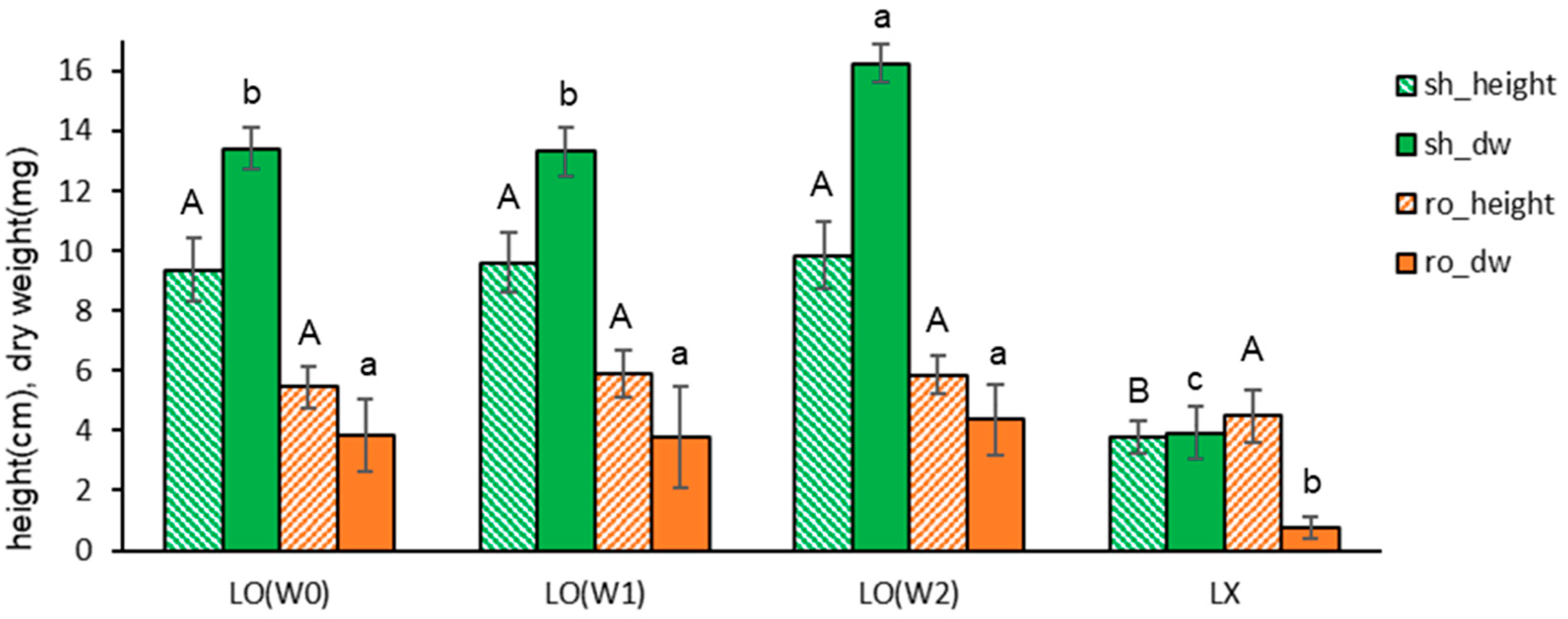
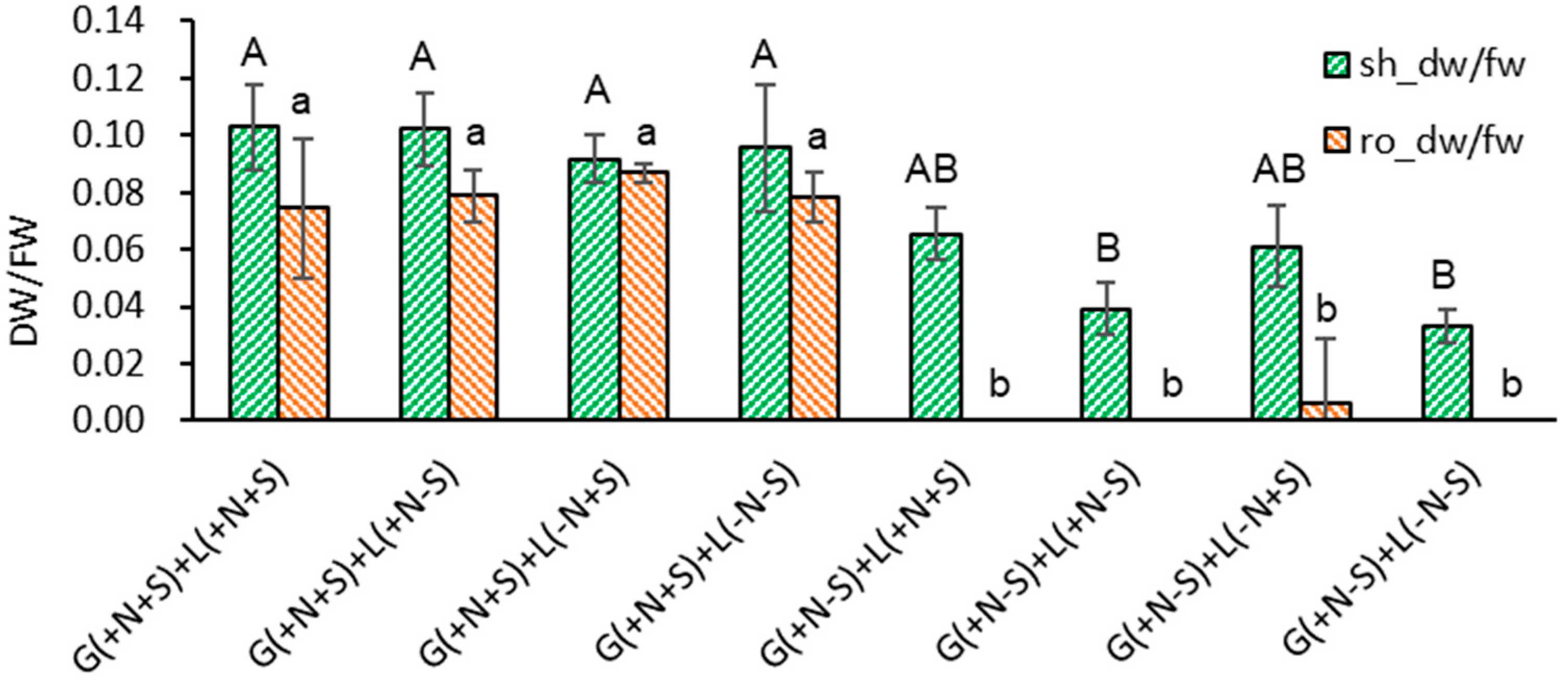

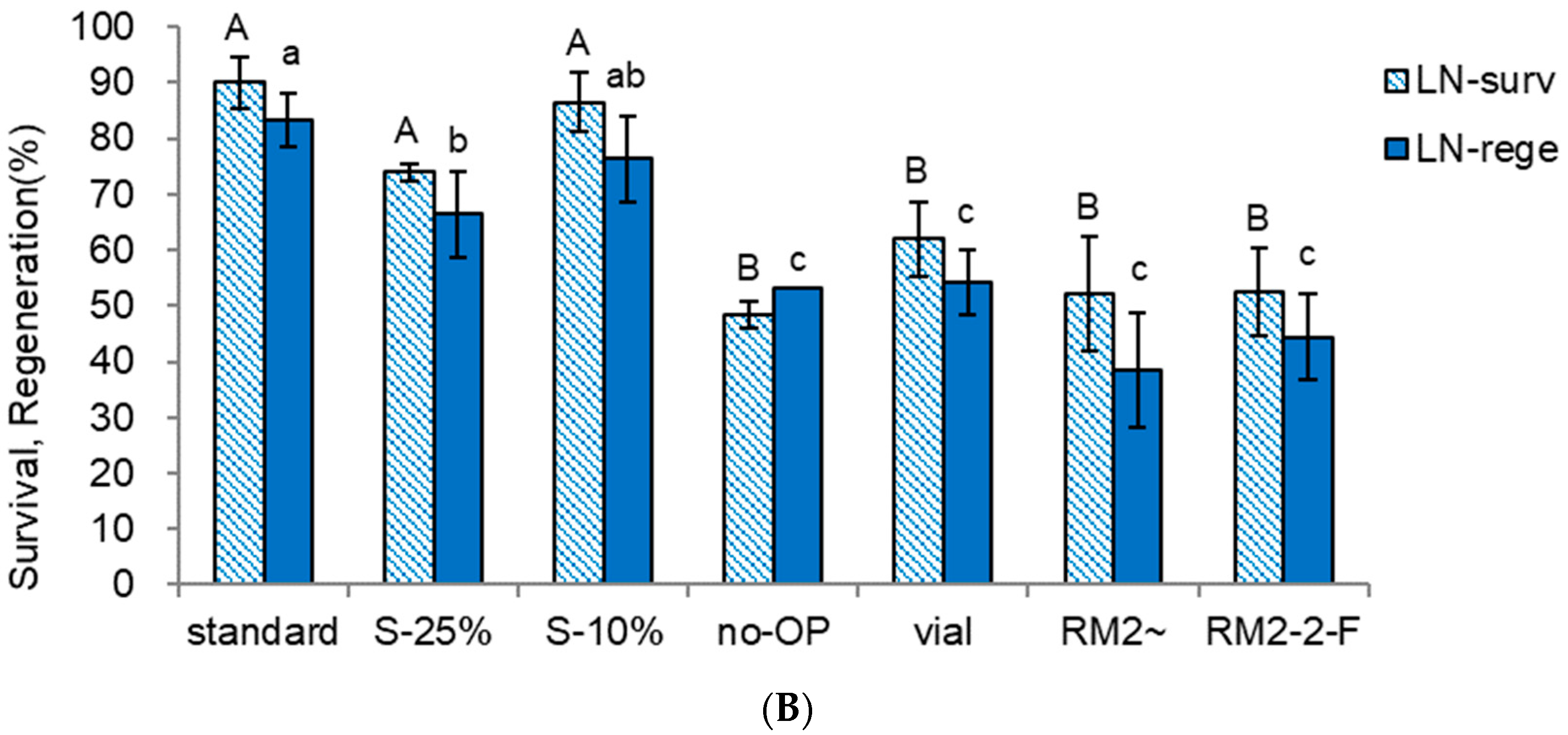

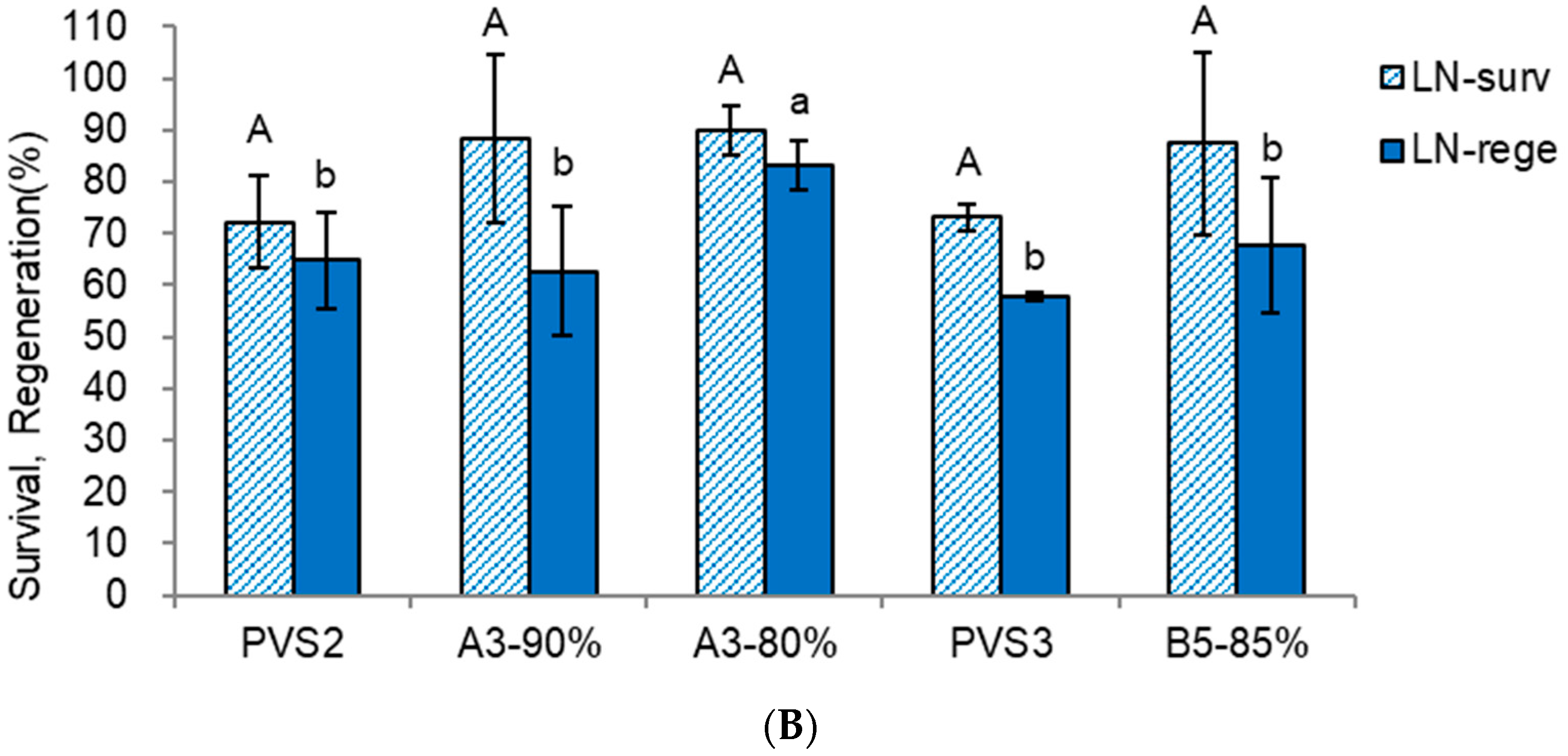
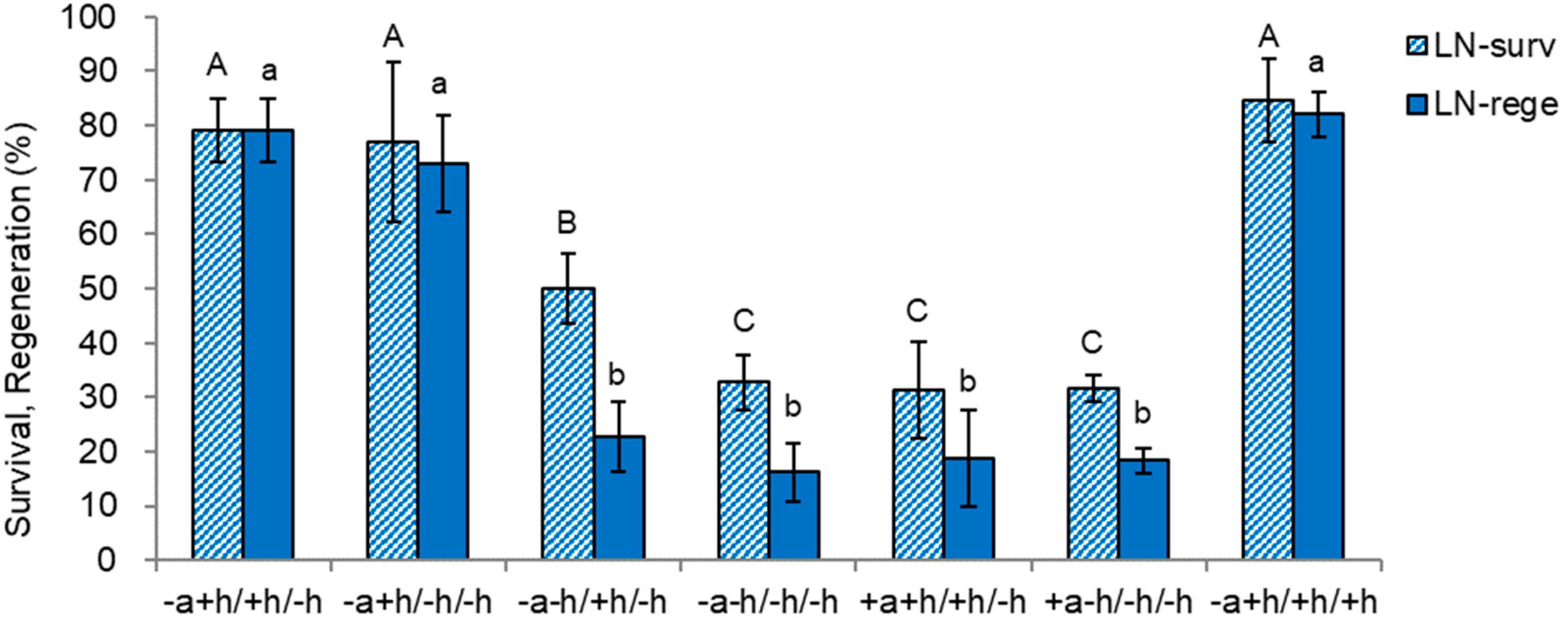

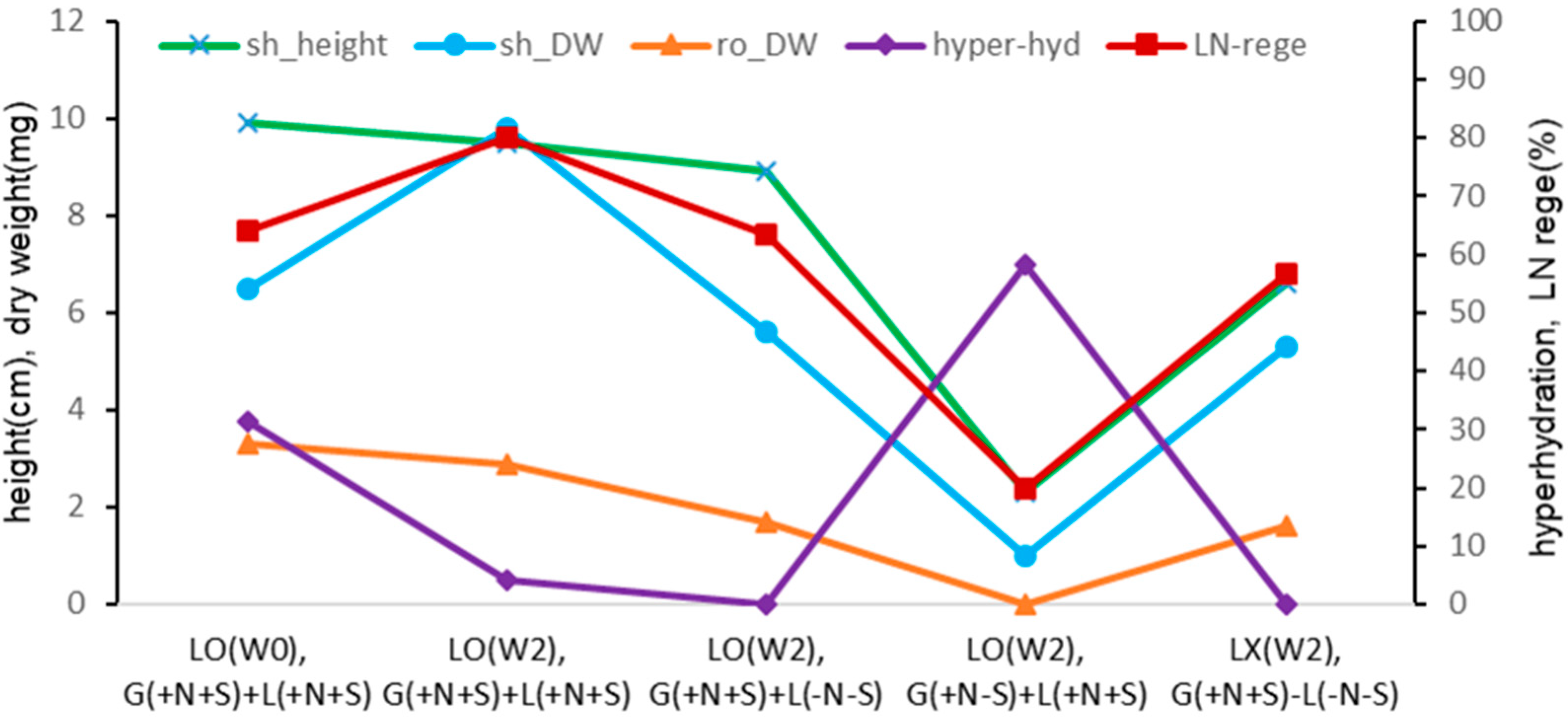
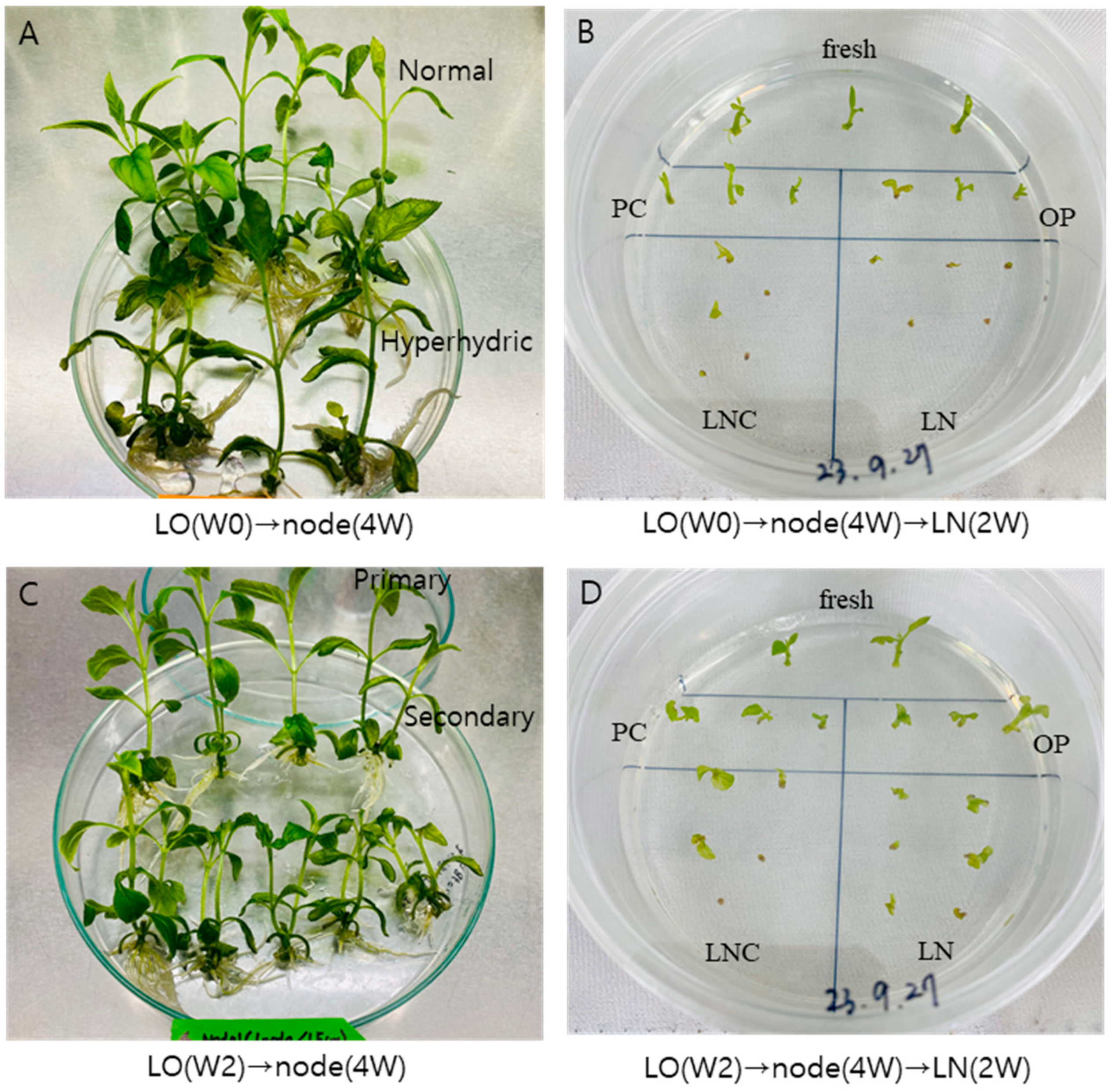
| No. | Normal/Hyperhydricity in Subcultured Plantlets (%) | Nodal Segment-Induced Shoots | LNC (%) | LN (%) | |||
|---|---|---|---|---|---|---|---|
| Primary/Secondary (cm) ** | Hyperhydricity (%) *** | Surv | Rege | Surv | Rege | ||
| 1. LO(W0) * | Normal (68.7%) | Primary (4.5) | 41.7 | 76.7 | 66.7 | 74.2 | 64.2 |
| Secondary (2.0) | 91.7 | 60.0 | 50.0 | 38.3 | 31.7 | ||
| Hyperhydric (31.3%) | Primary (4.5) | 100 | 80.0 | 50.0 | 60.0 | 50.0 | |
| Secondary (1.5) | 100 | 60.0 | 30.0 | 30.0 | 20.0 | ||
| 4. LO(W2) | Normal (95.8%) | Primary (6.5) | 0 | 100.0 | 83.3 | 93.8 | 80.0 |
| Secondary (2.5) | 25 | 70.0 | 60.0 | 55.0 | 50.0 | ||
| Hyperhydric (4.2%) | Primary (6.5) | 100 | 90.0 | 60.0 | 75.0 | 60.0 | |
| Secondary (1.5) | 100 | 70.0 | 40.0 | 45.0 | 35.0 | ||
| 7. LX | Normal (100%) | Primary (4.0) | 0 | 60.0 | 55.0 | 62.1 | 56.8 |
| Secondary (2.0) | 0 | 50.0 | 30.0 | 40.0 | 25.0 | ||
| Hyperhydric (0%) | - | - | - | - | - | - | |
| Set | No. | Medium Strength | Growth Regulators (mg L−1) | Gelling Agents (g L−1) ** | AC (g L−1) *** | Liquid Overlay **** | Light (Lamp) ***** | Code |
|---|---|---|---|---|---|---|---|---|
| Subculture medium and conditions | 1 | MS | − | Gellan gum 3 | − | LX | 2 | MSF *, standard |
| 2 | 1/2MS | − | Gellan gum 3 | − | LX | 2 | 1/2MSF | |
| 3 | MS | BA0.5 + NAA0.5 | Gellan gum 3 | − | LX | 2 | B0.5N0.5 | |
| 4 | MS | − | Gellan gum 3 | 1 | LX | 2 | AC1 | |
| 5 | MS | − | Agar 8 | − | LX | 2 | Agar8 | |
| 6 | MS | − | Gell 1.5 + Agar 4 | − | LX | 2 | Gel1.5 + Agar4 | |
| 7 | MS | − | Gellan gum 3 | − | LX | 1 | L1 | |
| Timing of liquid overlay | 1 | MS | − | Gellan gum 3 | − | LX | 2 | LX |
| 2 | MS | − | Gellan gum 3 | − | LO(W0) | 2 | LO(W0) | |
| 3 | MS | − | Gellan gum 3 | − | LO(W1) | 2 | LO(W1) | |
| 4 | MS | − | Gellan gum 3 | − | LO(W2) | 2 | LO(W2) |
| No. | Gellan Gum-Gelled Medium * | Liquid-Overlay Medium ** | Code |
|---|---|---|---|
| A1 *** | G(+N, +S) | +L(+N, +S) | G(+N+S)+L(+N+S) |
| A2 | G(+N, +S) | +L(+N, −S) | G(+N+S)+L(+N−S) |
| A3 | G(+N, +S) | +L(−N, +S) | G(+N+S)+L(−N+S) |
| A4 | G(+N, +S) | +L(−N, −S), ddw | G(+N+S)+L(−N−S) |
| B1 | G(+N, −S) | +L(+N, +S) | G(+N−S)+L(+N+S) |
| B2 | G(+N, −S) | +L(+N, −S) | G(+N−S)+L(+N−S) |
| B3 | G(+N, −S) | +L(−N, +S) | G(+N−S)+L(−N+S) |
| B4 | G(+N, −S) | +L(−N, −S) | G(+N−S)+L(−N−S) |
| Procedure | Treatment Conditions | Code | |||
|---|---|---|---|---|---|
| Protocol | Preculture | 10% sucrose, 31 h → 17.5% sucrose, 16 h | S-17.5%, st *** | ||
| 10% sucrose, 31 h → 25% sucrose, 16 h | S-25% | ||||
| 10% sucrose, 48 h | S-10% | ||||
| Osmoprotection | C4-35%, 30 min | OP, st | |||
| No osmoprotectant | no-OP | ||||
| Cooling/warming device | Aluminum foil-strips | Foil, st | |||
| Cryovial (2 mL) | Vial | ||||
| Regrowth medium * | RM1-RM2-MSF | RM1-2-F, st | |||
| RM2~ | RM2~ | ||||
| RM2-RM2-MSF | RM2-2-F | ||||
| Cryoprotection ** | A1-73.7% (PVS2) ice, 60 min | PVS2 | |||
| A3-90% ice, 60 min | A3-90% | ||||
| A3-80% ice, 60 min | A3-80%, st | ||||
| B1-100 (PVS3) 25 °C, 60 min | PVS3 | ||||
| B5-85% 25 °C, 60 min | B5-85% | ||||
| Post-LN | Ammonium ion and growth hormones in regrowth medium | Regrowth Step 1 | Step 2 | Step 3 | |
| 1. NH4NO3-free + GA1 + BA1 | →GA1 + BA1 | →MSF ** | −a+h/+h/−h, st | ||
| 2. NH4NO3-free + GA1 + BA1 | →MSF | →MSF | −a+h/−h/−h | ||
| 3. NH4NO3-free + MSF | →GA1 + BA1 | →MSF | −a−h/+h/−h | ||
| 4. NH4NO3-free + MSF | →MSF | →MSF | −a−h/−h/−h | ||
| 5. NH4NO3-containing + GA1 + BA1 | →GA1 + BA1 | →MSF | +a+h/+h/−h | ||
| 6. NH4NO3-containing + MSF | →MSF | →MSF | +a-h/−h/−h | ||
| 7. H4NO3-free + GA1 + BA1 | →GA1 + BA1 | →GA1 + BA1 | −a+h/+h/+h | ||
| Donor plant vigor | Liquid overlay | 1. Liquid overlay at week 0, G(+N+S)+L(+N+S) | LO(W0), G(+N+S)+L(+N+S) | ||
| 2. Liquid overlay at week 2, G(+N+S)+L(+N+S) | LO(W2), G(+N+S)+L(+N+S), st | ||||
| 3. Liquid overlay at week 2, G(+N+S)+L(−N−S) (ddw) | LO(W2), G(+N+S)+L(−N−S) | ||||
| 4. Liquid overlay at week 2, G(+N−S)+L(+N+S) | LO(W2), G(+N−S)+L(+N+S) | ||||
| 5. no Liquid overlay, G(+N+S)−L(−N−S) | LX, G(+N+S)−L(−N−S) | ||||
Disclaimer/Publisher’s Note: The statements, opinions and data contained in all publications are solely those of the individual author(s) and contributor(s) and not of MDPI and/or the editor(s). MDPI and/or the editor(s) disclaim responsibility for any injury to people or property resulting from any ideas, methods, instructions or products referred to in the content. |
© 2024 by the authors. Licensee MDPI, Basel, Switzerland. This article is an open access article distributed under the terms and conditions of the Creative Commons Attribution (CC BY) license (https://creativecommons.org/licenses/by/4.0/).
Share and Cite
Lee, H.; Park, H.; Park, S.-U.; Kim, H. Liquid Overlay-Induced Donor Plant Vigor and Initial Ammonium-Free Regrowth Medium Are Critical to the Cryopreservation of Scrophularia kakudensis. Plants 2024, 13, 2408. https://doi.org/10.3390/plants13172408
Lee H, Park H, Park S-U, Kim H. Liquid Overlay-Induced Donor Plant Vigor and Initial Ammonium-Free Regrowth Medium Are Critical to the Cryopreservation of Scrophularia kakudensis. Plants. 2024; 13(17):2408. https://doi.org/10.3390/plants13172408
Chicago/Turabian StyleLee, Hyoeun, Hana Park, Sang-Un Park, and Haenghoon Kim. 2024. "Liquid Overlay-Induced Donor Plant Vigor and Initial Ammonium-Free Regrowth Medium Are Critical to the Cryopreservation of Scrophularia kakudensis" Plants 13, no. 17: 2408. https://doi.org/10.3390/plants13172408





